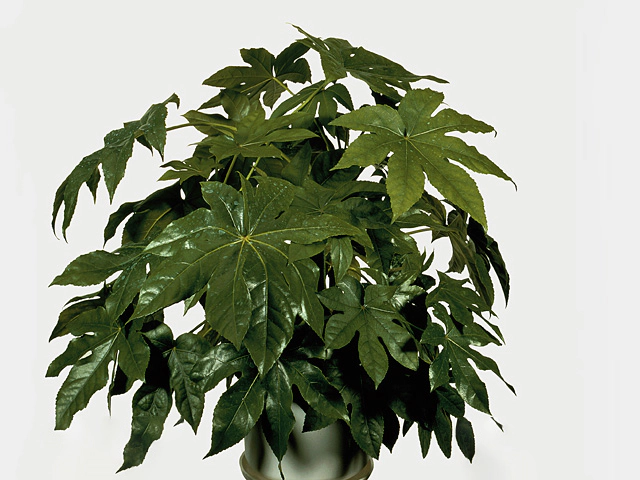Fatsia japonica other

| Fruit type | Berry |
| Leaf type | Foliage leaf |
| Winter hardness | Limited (USDA-zone 8) |
| Inflorescence | Umbel(-like) |
| Structure (tissues) | Woody |
| Leaf surface | Glossy |
| Light conditions | Sunny; Semi-shades |
| Plant, growth type | Erect |
| Toxicity (if consumed) | Fairly |
| Moisture requirements | Moist |
Fatsia japonica, commonly known as the castor oil plant, is an eye-catching and versatile plant that can be a great addition to any garden. With its unique features and ability to thrive in various light conditions, it is sure to grab attention and bring a touch of beauty to any landscape.
One of the most distinctive characteristics of Fatsia japonica is its fruit type. It produces small, round berries that add a pop of color to the plant, making it even more visually appealing. Additionally, its foliage leaf type gives it a lush and full appearance, adding depth to the overall aesthetic.
In terms of winter hardiness, Fatsia japonica can withstand limited cold temperatures, specifically in USDA-zone 8. This makes it suitable for gardens in regions with milder winters, where it can continue to flourish even in the colder months. However, gardeners in colder regions may need to take extra precautions to protect the plant during winter.
The inflorescence of Fatsia japonica is umbrella-like, creating clusters of small flowers that add an elegant touch to the plant. These blooms can be seen throughout the growing season, bringing a sense of life and vibrancy to the overall landscape.
The structure of Fatsia japonica is woody, giving it a sturdy and durable nature. This makes it a long-lasting addition to any garden, ensuring years of enjoyment and beauty. The glossy leaf surface further enhances the appeal of the plant, reflecting light and adding a touch of elegance.
As for light conditions, Fatsia japonica thrives in sunny and semi-shaded areas. This versatility allows gardeners to place it in various locations, making it suitable for different garden designs and arrangements. It can be a focal point in a sunny corner or provide a lush backdrop in semi-shaded areas.
It is important to note that Fatsia japonica is fairly toxic if consumed. Therefore, caution should be exercised, especially if there are children or pets around. It is advisable to keep a safe distance or use protective measures to prevent accidental ingestion.
Moisture requirements for Fatsia japonica lean towards a moist environment. Regular watering is necessary to keep the plant healthy and thriving. However, over-watering should be avoided, as it can lead to root rot or other moisture-related issues. Finding a balance in watering will help maintain the plant's optimal conditions.
In conclusion, Fatsia japonica, or the castor oil plant, is a versatile and eye-catching addition to any garden. With its unique fruit type, glossy foliage, and umbrella-like inflorescence, it adds beauty and interest to the landscape. Its ability to tolerate different light conditions and moisture levels makes it suitable for various garden designs. However, caution should be exercised due to its toxicity if consumed. With proper care and attention, Fatsia japonica can thrive in gardens and bring delight to the senses for years to come.
Market availability index by month:
| Jan. | Feb. | Mar. | Apr. | May | Jun. | Jul. | Aug. | Sep. | Oct. | Nov. | Dec. |
|---|---|---|---|---|---|---|---|---|---|---|---|
| 4 | 3 | 2 | 2 | 2 | 2 | 2 | 3 | 2 | 3 | 2 | 2 |